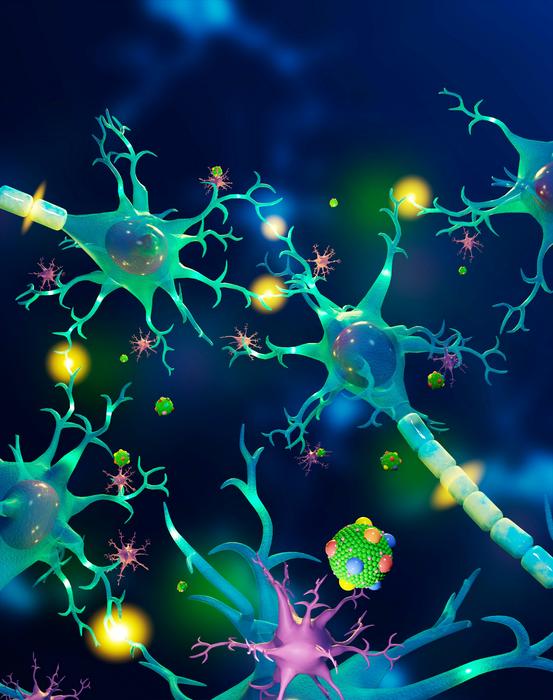Alzheimer’s disease, a heart-wrenching affliction affecting millions worldwide, stands as an ongoing challenge in medical research. The accumulation of amyloid peptides, known as misfolded amyloid-beta (Aβ) peptides, within the brain is considered a primary catalyst for this debilitating condition. These toxic molecules contribute to cell death and are frequently found in the brains of Alzheimer’s patients. However, scientists at Chalmers University of Technology in Sweden have recently unveiled a promising breakthrough. They’ve demonstrated that yeast cells laden with misfolded amyloid peptides can regain their vitality after treatment with graphene oxide nanoflakes.
Understanding the Alzheimer’s Dilemma
Alzheimer’s disease, an incurable affliction leading to dementia and eventual fatality, takes a heavy toll on patients and their families worldwide. An alarming statistic from Alzheimer’s News Today reveals that these diseases cost approximately one percent of the global gross domestic product. At the core of Alzheimer’s lies the accumulation and aggregation of misfolded amyloid-beta peptides (Aβ peptides) in the brain. These rogue molecules initiate a cascade of destructive processes within neurons, causing a loss of essential cell functions, cell death, and ultimately, a decline in brain function. Up to this point, there have been no effective strategies for combating this amyloid buildup.

CREDIT
Illustration: Chalmers University of Technology / Katharina Merl
Graphene Oxide’s Remarkable Impact
Researchers at Chalmers University of Technology have shown that graphene oxide treatment significantly reduces the levels of aggregated amyloid peptides in a yeast cell model. What makes this discovery even more intriguing is the elucidation of the mechanism behind this phenomenon. Graphene oxide influences cell metabolism in a way that enhances their resistance to misfolded proteins and oxidative stress, a previously unreported observation.
Digging into the Mechanisms
In Alzheimer’s disease, amyloid aggregates inflict their neurotoxicity by disrupting various cellular processes, including stress in the endoplasmic reticulum, a critical component of cell protein production. This disruption impairs the cell’s ability to handle misfolded proteins, leading to their accumulation. Furthermore, these aggregates impact the function of mitochondria, the cell’s powerhouses, which exposes neurons to increased oxidative stress, particularly damaging to brain cells.
The research at Chalmers utilized baker’s yeast, Saccharomyces cerevisiae, as an in vivo model for human cells due to their similarities in controlling protein quality. These yeast cells mirror neurons affected by the accumulation of amyloid-beta42, the most aggregation-prone form of amyloid peptide. This resemblance includes accelerated aging, endoplasmic reticulum stress, mitochondrial dysfunction, and elevated production of harmful reactive oxygen radicals.
Graphene Oxide Nanoflakes: A Potential Game Changer
Graphene oxide nanoflakes are two-dimensional carbon nanomaterials renowned for their unique properties, such as outstanding conductivity and high biocompatibility. These nanoflakes are water-soluble and readily interact with biomolecules, including proteins. When graphene oxide infiltrates living cells, it disrupts the self-assembly processes of proteins, hindering the formation of protein aggregates and promoting the disintegration of existing ones.
Researcher Santosh Pandit explains that graphene oxide appears to employ two distinct pathways to mitigate the toxic effects of amyloid-beta42. Firstly, it directly prevents the accumulation of these toxic peptides. Secondly, it activates specific genes responsible for stress responses, enhancing the cell’s ability to handle misfolded proteins and oxidative stress.
A Promising Path Forward
While the treatment of Alzheimer’s patients remains a question for the future, graphene oxide holds immense potential in neurodegenerative disease research. Chalmers’ research group has already demonstrated that graphene oxide can reduce the toxic effects of protein aggregates specific to Huntington’s disease in a yeast model. The next frontier involves exploring the development of a drug delivery system based on graphene oxide for Alzheimer’s disease and investigating its potential benefits in other neurodegenerative conditions like Parkinson’s disease.
Proteins play a significant role in Alzheimer’s disease, but the relationship is complex. Alzheimer’s is primarily characterized by the accumulation of abnormal protein deposits in the brain, which can contribute to the progression of the disease. Here are answers to your specific questions:
- How does protein affect Alzheimer’s? In Alzheimer’s disease, two types of abnormal protein deposits are primarily involved: amyloid plaques and tau tangles.
- Amyloid plaques: Amyloid-beta peptides, specifically the misfolded and aggregated forms known as Aβ plaques, accumulate in the brain. These plaques can disrupt normal brain function and contribute to the death of neurons, leading to cognitive decline.
- Tau tangles: Tau proteins normally help stabilize the structure of microtubules within neurons. However, in Alzheimer’s, tau proteins can become abnormal and form tau tangles, which disrupt the functioning of neurons and are associated with memory and cognitive problems.
It’s important to note that these proteins when they accumulate abnormally, can have toxic effects on brain cells and contribute to the progression of Alzheimer’s disease.
- What are the toxic proteins that cause dementia? The toxic proteins associated with dementia, particularly in Alzheimer’s disease, are amyloid-beta (Aβ) plaques and tau tangles, as mentioned earlier. These proteins can disrupt normal neuronal function and lead to cognitive decline, memory problems, and other symptoms characteristic of dementia.
- Is Alzheimer’s caused by too much protein? Alzheimer’s is not caused by the presence of proteins in the brain but rather by the abnormal accumulation and aggregation of specific proteins, namely Aβ plaques and tau tangles. It’s not a matter of too much protein but rather the misfolding and aggregation of these proteins that contribute to the disease.
- What protein prevents Alzheimer’s? There is no single protein that can prevent Alzheimer’s disease, and the development of effective treatments for Alzheimer’s remains an ongoing area of research. However, some studies suggest that certain lifestyle factors, including a balanced diet rich in antioxidants, omega-3 fatty acids, and other nutrients, may help reduce the risk of Alzheimer’s and support overall brain health.
Additionally, staying mentally and socially active, regular physical exercise, and managing cardiovascular risk factors like high blood pressure and diabetes are all important strategies for potentially reducing the risk of Alzheimer’s disease. There are ongoing clinical trials and research efforts aimed at finding treatments and preventive measures for Alzheimer’s, but as of my last knowledge update in September 2021, there is no definitive protein or medication that can prevent the disease. It’s essential to consult with healthcare professionals for the most up-to-date information and guidance on Alzheimer’s prevention and management.










